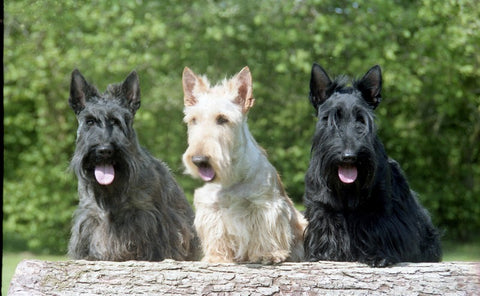
Scottish Terrier
Quick Facts:
- AKC recognized in 1885
- Lifespan: 12 years
- Size: Medium
- Energy: Medium
- Recommended Crate Size: 30” dog crate*
Return to main Dog Crate Size Breed Chart.
Scottish Terriers are actually an old breed, despite it being somewhat undocumented. The origin of this dog is believed to be from Pliny the Elder, a Roman author dating back to 55 B.C. This breed is also believed to be descendants of the ancient breeds found in Scotland, which many say are a foundation breeds of all Terriers found in the world today.
The Scottish Terrier was originally bred for hunting and catching prey. They simply have the natural instinct to dig and it is a central characteristic. Since they are bred as working dogs, they have a decent energy level, which requires a daily exercise routine and regular mental stimulation.
Breed
The American Kennel Club formally recognized the Scottish Terrier in 1885. These medium energy dogs are often considered big dogs in a small dog’s body. They are independent, feisty, and sometimes excitable. Unlike many dog breeds, Scotties do not demand a large amount of attention, but they can be aggressive with other dogs and animals. They can also be stubborn when training.
Appearance
The Scottish Terrier is compact, short-legged, small, and sturdy. They have a thick, wiry, hard, and weather-resistance coat. Scottish Terriers weigh between 18 to 22 pounds and are about 10 inches in height.
The unique characteristics of the Scottie is the distinctive beard around its muzzle, long eyebrows, and long wiry coat, which almost looks like a long skirt. Even though they have long coats, it only sheds a little. People usually think of the Scottish Terrier as black, but they actually also come in other colors such as brindle, grey, or wheaten.
Nutrition
It is recommended to provide feed formulated to medium-sized breeds. It is highly recommended to discuss your dog’s feed with your veterinarian and/or breeder in order to determine size and frequency of meals in order to ensure a health, long life. It is also important to ensure that clean, fresh water is always available.
Grooming
This dog breed has a two-layered coat. The topcoat is wiry and hard while the undercoat is dense and soft. The Scotties hair is the type to shed very little because its fur keeps on growing. They do not need frequent bathing. Its coat should be brushed weekly using a stiff brush and toothed comb as well as scissors for occasional trimming.
Exercise
The Scottish Terrier is a moderately active breed. They have the tendency to become destructive when they do not get enough exercise or are under stimulated. Even though they are active, running is not their favorite activity because of their short legs. Walking is a suitable choice.
Pet Crate Size
Pet Crates Direct recommends 30” dog crates* for most adult Scottish Terriers.
* Links for crate sizes will bring you to the most appropriate Amazon page.



